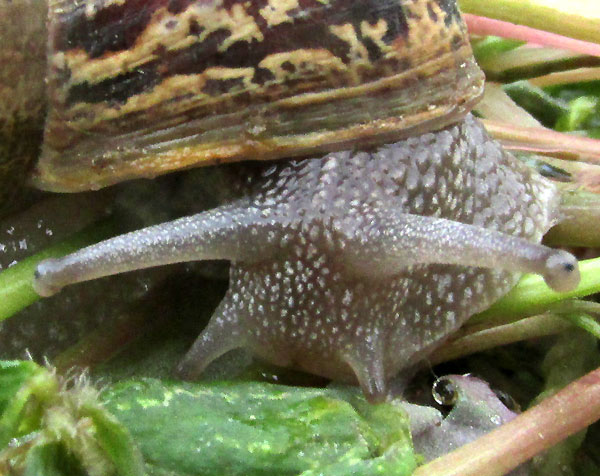Excerpts from Jim Conrad's
Naturalist Newsletter
entry dated June 24, 2022, issued from near Tequisquiapan, elevation about 1,900m (6200 ft), N20.565°, W99.890°, Querétaro state, MÉXICO
GARDEN SNAIL

All during the long dry season a fair-sized snail hung on the toilet door, glued there with dried mucus spread across the shell's bottom entrance hole when the snail crawled there and stopped at the end of the rainy season, last December or so. Last week the first soaking rain of the new rainy season sent dozens of Garden Snails, HELIX ASPERSA, into the backyard, where they grazed in the parched grass until the sun came out. That's one of them above.
This species is an invasive, native to western Europe and countries bordering the Mediterranean and Black Seas. Except for its unusual adaptability and larger size -- adult shell width reaching about 3.8cm (1.5 inches) -- it's a fairly normal land snail. Mostly it eats plant material, including certain garden plants, and decaying organic matter. Mainly it's nocturnal, but on rainy days it may come out.

Most people know that snails bear both male and female reproductive organs. They can mate with themselves if they want to, but normally they find a mate, with whom they line up so that they can inseminate one another at the same time.
Less known is that during the mating process each snail pushes a sharp "love dart" toward the other -- in Garden Snails about 9mm-long (1/3 inch) -- with the tip often penetrating the partner's body wall. Until fairly recently it was suggested that this was done to "stimulate receptivity," though that idea never was too convincing. A 2001 study by Michael Landolfa and others, entitled "Dart shooting influences paternal reproductive success in the snail Helix aspersa (Pulmonata, Stylommatophora)" found that snails who shoot darts effectively have a significantly greater reproductive success than those who shoot poorly. Maybe the partner who receives a fumbled shot somehow reduces egg production, thus evolutionarily favoring the genes of more capable shooters.
Another study, a 1990 one by O. Lorvelec entitled "Le retour au gite chez l'escargot Helix aspera. Étude au laboratoire," found that this species appears to have a homing instinct. Individuals don't need to orient relative to such features as soil, rocks, plants and natural light, nor is the instinct related to micro-climatic conditions or social behavior. However, in 2014 it was found that the homing instinct can be overcome if they're removed by at least 20m (66ft) from their home.
Back in the 70s during my first trip to Spain a fellow invited me to camp in his garden. In the evening he came out with a big pot, poured in water and added garlic, black pepper, cumin, and bay leaves, got it boiling, then appeared with a bucket full of live snails from the garden, which he dumped into the boiling water. In a few minutes he proudly invited me to join. I explained that I was, and am, a vegetarian, but I understand that they tasted like fried eggs. Spaniards and the French prefer the larger Helix pomatia, the Escargot, but you can see from the binomial that the Escargot belongs to the same genus as ours. In fact, our snail also is much hunted and cooked by certain people, including here in Mexico.